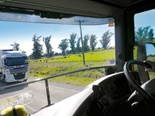Comment: Making New Zealand roads safer
More passing and slow-vehicle lanes on state highways, increase in the number of rest areas, and better information to drivers are just some of the ways to make NZ roads safer
I think all heavy truck drivers in New Zealand would agree that there are some common issues they all face on our roads that could easily be solved with small infrastructure improvements.
Firstly, the lack of passing opportunities for faster motorists when trying to pass trucks is something that frustrates many people and can lead to some making foolish and risky decisions. You only have to look at the publicly available dashcam footage from any truck around the country to know just how common it is for a motorist to become frustrated at not being able to overtake a truck safely and instead do so in front of the oncoming traffic.

More passing and slow-vehicle lanes on state highways and busier regional roads will go a long way to solving this issue.
Secondly, the number of rest areas that can be safely accessed by large trucks has for many years been a problem for our industry. Our motorway network is not blessed with the kind of conveniences and service areas that are common in Europe, Australian, and the US, which is understandable given our smaller population. However, we are not asking for restaurants and picture theatres, merely rest areas large enough to safely pull over and that include access to clean and tidy facilities to take a bathroom break and freshen up.
It is also important that there is better information provided to commercial drivers on where suitable stretches of road exist for heavy vehicles to be able to pull over at a rest area. This is especially important where road closures for snow, ice, flooding, and slips are common and heavy traffic is diverted to unfamiliar routes.
Last year, NZTA and the Road Transport Association developed the TruckR app, designed to help truck drivers travelling on the alternate Picton to Christchurch route after the Kaikoura earthquake.
The app highlights stopping areas suitable for heavy vehicles, passing lanes, trailer swap areas, one-lane bridges, and places with limited cell phone coverage. It includes information on the location of petrol stations, food outlets, and public toilets. The app
also connects to NZTA’s traffic alert system, giving drivers up-to-date information about roadworks, crashes, and road closures.
The obvious solution is to extend that app to the whole of New Zealand’s roading network. That would provide thousands of commercial drivers with information about their intended route available at their fingertips.
Another idea that could be used in conjunction with the TruckR app is giving a visual reminder for drivers by using a sign on a roadside delineation marker post for an approaching rest area or pull-over point. This visual clue could be as simple as using a certain coloured cat’s eye spaced out prior to the pull over point. Three green cat’s eyes placed on a marker post approximately 300 metres out from the rest area, then two when it’s 200 metres out, and one when you are 100 metres out would do the trick.
This addresses two safety issues:
- It alerts the driver that a suitable rest area is coming up and it works subconsciously to remind him or her to have a break away from the wheel.
- It also gives the truck an opportunity to let faster traffic go without the need for a full passing lane.
As New Zealand’s freight task expands over the next few years and more trucks inevitably hit the road to carry it out, we need to do more to manage the road network and make it as safe as possible. More passing opportunities, rest areas, and better information for heavy vehicle drivers will all help to achieve that.
Keep up to date in the industry by signing up to Deals on Wheels' free newsletter or liking us on Facebook.




.jpg)


.jpg)








